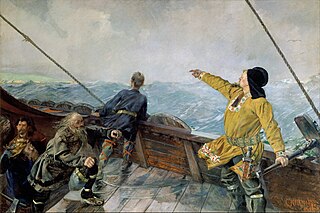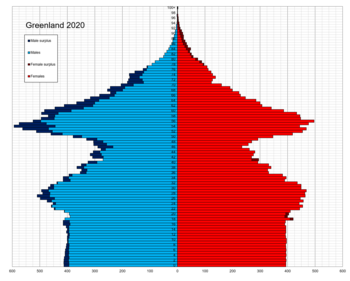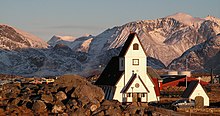
Greenland is a North American autonomous territory of the Kingdom of Denmark. It is the larger of two autonomous territories within the Kingdom, the other being the Faroe Islands; the citizens of both territories are full citizens of Denmark. As Greenland is one of the Overseas Countries and Territories of the European Union, citizens of Greenland are European Union citizens. The capital and largest city of Greenland is Nuuk. Greenland lies between the Arctic and Atlantic oceans, east of the Canadian Arctic Archipelago. It is the world's largest island, and is the location of the northernmost area of the world – Kaffeklubben Island off the northern coast is the world's northernmost undisputed point of land, and Cape Morris Jesup on the mainland was thought to be so until the 1960s.
Greenlandic may refer to:

The history of Greenland is a history of life under extreme Arctic conditions: currently, an ice sheet covers about eighty percent of the island, restricting human activity largely to the coasts. The first humans are thought to have arrived in Greenland around 2500 BCE. Their descendants apparently died out and were succeeded by several other groups migrating from continental North America. There has been no evidence discovered that Greenland was known to Norsemen until the ninth century CE, when Norse Icelandic explorers settled on its southwestern coast. The ancestors of the Greenlandic Inuit who live there today appear to have migrated there later, around the year 1200, from northwestern Greenland.

Nuuk is the capital of and most populous city in Greenland, an autonomous territory in the Kingdom of Denmark. Nuuk is the seat of government and the territory's largest cultural and economic center. The major cities from other countries closest to the capital are Iqaluit and St. John's in Canada and Reykjavík in Iceland. Nuuk contains a third of Greenland's population and its tallest building. Nuuk is also the seat of government for the Sermersooq municipality. In January 2023, it had a population of 19,604. Nuuk is considered a modernized city after the policy began in 1950.

Hans Poulsen Egede was a Dano-Norwegian Lutheran missionary who launched mission efforts to Greenland, which led him to be styled the Apostle of Greenland. He established a successful mission among the Inuit and is credited with revitalizing Dano-Norwegian interest in the island after contact had been broken for about 300 years. He founded Greenland's capital Godthåb, now known as Nuuk.

Skræling is the name the Norse Greenlanders used for the peoples they encountered in North America. In surviving sources, it is first applied to the Thule people, the proto-Inuit group with whom the Norse coexisted in Greenland after about the 13th century. In the sagas, it is also used for the peoples of the region known as Vinland whom the Norse encountered and fought during their expeditions there in the early 11th century.

The Danish Realm, officially the Kingdom of Denmark, is a country and refers to the area over which the monarch of Denmark is head of state. It consists of metropolitan Denmark—the kingdom's territory in continental Europe and sometimes called "Denmark proper" —and the realm's two autonomous regions: the Faroe Islands in the North Atlantic and Greenland in North America. The relationship between the three parts of the Kingdom is also known as The unity of the Realm.

The Greenlandic Inuit are the indigenous and most populous ethnic group in Greenland. Most speak Greenlandic and consider themselves ethnically Greenlandic. People of Greenland are citizens of Denmark.
The Bishop of Greenland is a diocesan bishop of the Church of Denmark, and the leader of the Church of Greenland, which is an episcopal church in the Lutheran tradition.

Greenlandic independence is a political ambition of some political parties, advocacy groups, and individuals of Greenland, an autonomous territory within the Kingdom of Denmark, to become an independent sovereign state.
The Greenland Provincial Council was the provincial government of Greenland between 1950, when it was formed from the union of the earlier North and South Greenland Provincial Councils, and 1 May 1979, when it was replaced by the Greenland Home Rule Government and its Parliament.

Grænlendingar were Norsemen that came from Iceland to settle on the Island of Greenland in the years following 986. The Grænlendingar were the first Europeans to explore and temporarily settle North America. It is assumed that they developed their own language that is referred to as Greenlandic Norse, not to be confused with Eskimo-Aleut Greenlandic language. Their settlements existed for about half a millennium before they were abandoned for reasons still not entirely clear.

Danish Greenlanders are ethnic Danes residing in Greenland and their descendants.

Greenlandic people in Denmark are residents of Denmark with Greenlandic or Greenlandic Inuit heritage. According to StatBank Greenland, as of 2020, there were 16,780 people born in Greenland living in Denmark, a figure representing almost one third of the population of Greenland. According to a 2007 Danish government report, there were 18,563 Greenlandic people living in Denmark. The exact number is difficult to calculate because of the lack of differentiation between Greenlandic and Danish heritage in Danish government records and also due to the fact that the way in which people identify themselves is not always a reflection of their birthplace. As of 2018, there were 2,507 Greenlanders enrolled in education in Denmark.

The majority of the Greenlandic population is Christian and associates with the Church of Denmark via the Church of Greenland, which is Protestant in classification and Lutheran in orientation. The Church of Denmark is the established church through the Constitution of Denmark; this applies to all of the Kingdom of Denmark, except for the Faroe Islands, as the Church of the Faroe Islands became independent in 2007. But traditional Inuit spiritual beliefs remain strong in many of Greenland's remote communities.

Kristian Mørch was a Greenlandic Inuit prelate who became Greenland's first bishop in 1993 after the restoration of the Diocese of Greenland. He is also considered as the mastermind behind the formation of the Church of Greenland, distinct from the Church of Denmark.
Vera Leth is a Greenlandic civil servant who has been the County Council Ombudsman for the Parliament of Greenland since 1997.
Marie Margrethe Ruth Ane Thomsen Heilmann is a Greenlandic teacher and politician who represents the Siumut party. In January 2008, she became the first female speaker of the Inatsisartut or Parliament of Greenland. The Parliament honoured her in April 2016 with the Nersornaat (gold), a medal for meritorious service, for a political career lasting over 20 years.
The levels of education in Greenland are primary, secondary and higher education. A 10-year primary education is compulsory for all children aged between 6 and 16. Education in Greenland is controlled by the Greenlandic Department of Education. Danish is taught as a second language starting in the first grade.















